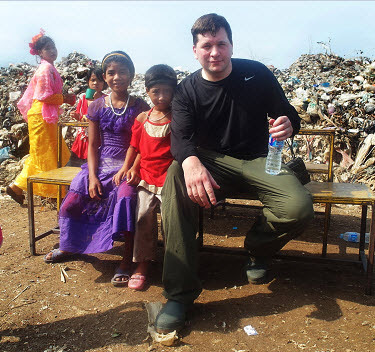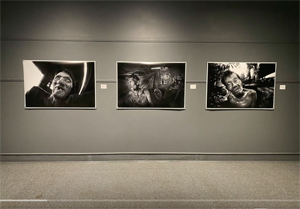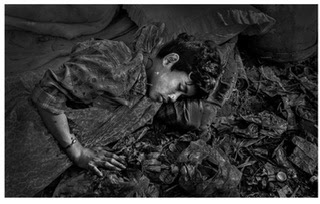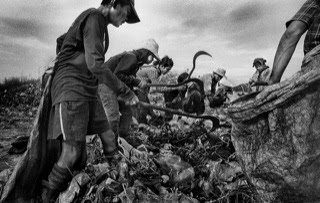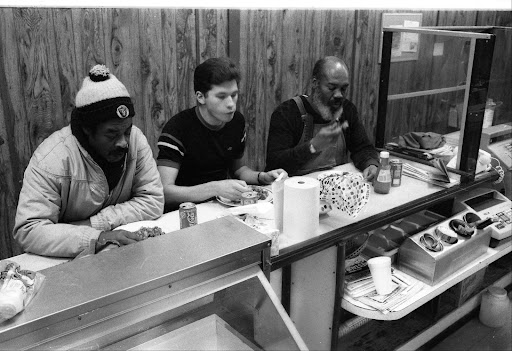Well I did my first wet plate work from chemistry I mixed by hand. IT WORKED! haha  Loads of fun and it worked! The plates (first time I have used that
word) are washing now. I will try posting then in a day or two. Got to
do my first varnishing on them as well.
Loads of fun and it worked! The plates (first time I have used that
word) are washing now. I will try posting then in a day or two. Got to
do my first varnishing on them as well.
Here is what I did.
-I made small 4x5 tintypes using my Speed Graphic and 178mm f2.5 Aero Ektar lens (tiny depth of field). Might try my Graflex next time and do a portrait.
- Subject was a still life of a cross and rosy that was part of my grand mothers funeral. The cross was on her coffin and the rosary in her hand during the funeral ceremony.
- I worked with 2 collodions (got images on both). Quinn's Quick Clear and Poe Boy.
- I shot at night in using a Speedotron 4800 flash unit.
- I used 2 types of developer a normal Ferrous Sulfate and a Quinn's Vinegar version developer.
Most everything seemed to work. I had some exposure issues which I mostly solved by adjusting the flash power. I had other problems of course. Pouring mistakes, dropped a plate face down after the pour. Have lots of weird marking stuff going on the plate as well, not 100% sure what they are and why they are happening. But who cares! I am a beginner and am a very happy with my first attempts! Years of learning ahead of course and wet plate on glass Ambrotyes and glass Negatives is a whole higher level. Going large also is a major step up, as is working at different temperatures.
Bit by bit we are going to get this done thou. After all, I have to rationalize the big trailer buy, the big camera buy, the multiple big lens buys And the 500 other buys!
And the 500 other buys!
The Poe Boy Collodion required one hell of a lot more exposure compared to the Quinn Quick Clear collodion. With QQC I exposed at 4800 W with 2 flash heads and dialed back the Speedotron flash to -2. With the Poe Boy I had to use full power and pop the flashes 3 times (that is a lot more light, a LOT LOT more light).
Note* My thinking on the Poe Boy Collodion and the Vinegar developer is to allow ease of use, cheaper use, chemistry more easy to find use, later on when I go Ultra Large Format and am making 35 inch ambrotypes and maybe making negatives on glass.
Poe Boy does not use extra ether and does not uses cheaper salts plus no Cadmium. If I can work out a working system for that type Collodion I will be ahead of the game. No need to buy extra ether (difficult) no need to use Cadmium Bromide (safer). The longer wet times because of more alcohol might also help me when I am working with 35x35 plates, more time to get things done.
I want good plates with a look I like. If I can achieve that by cutting Ether and Cadmium all the better, if it does not work I will just use QQC Collodion and dump the Poe Boy. It is worth a try, I am a newby what do I care! One of the fun things about about this whole wet plate thingy, is you follow rules others have taught you but you can also make some of your own!
The Vinegar developer is sort of the same idea. Not sure how practical the formula is, but white vinegar is available in any grocery most anywhere in Canada, Glacial Acetic Acid is not. So the thinking there is I can get that ingredient as I need on the road anywhere in Canada, it simplifies things. that is assuming I can get the developer to work. I can be up in the Canadian North, in the middle of nowhere and go buy Vinegar for my developer. I like that idea.
I will try to find the best working systems for this KANATA project which will last 10-15 years (not started it yet). SO FAR SO GOOD!
Update* I am happy, this all seems DO-ABLE now. It is very early but I believe, at least today I believe, that I will be able to chase down my KANATA wet plate dreams!! Look out Canada, here I come!
"Ain't Photography Grand!!"
Here is what I did.
-I made small 4x5 tintypes using my Speed Graphic and 178mm f2.5 Aero Ektar lens (tiny depth of field). Might try my Graflex next time and do a portrait.
- Subject was a still life of a cross and rosy that was part of my grand mothers funeral. The cross was on her coffin and the rosary in her hand during the funeral ceremony.
- I worked with 2 collodions (got images on both). Quinn's Quick Clear and Poe Boy.
- I shot at night in using a Speedotron 4800 flash unit.
- I used 2 types of developer a normal Ferrous Sulfate and a Quinn's Vinegar version developer.
Most everything seemed to work. I had some exposure issues which I mostly solved by adjusting the flash power. I had other problems of course. Pouring mistakes, dropped a plate face down after the pour. Have lots of weird marking stuff going on the plate as well, not 100% sure what they are and why they are happening. But who cares! I am a beginner and am a very happy with my first attempts! Years of learning ahead of course and wet plate on glass Ambrotyes and glass Negatives is a whole higher level. Going large also is a major step up, as is working at different temperatures.
Bit by bit we are going to get this done thou. After all, I have to rationalize the big trailer buy, the big camera buy, the multiple big lens buys
The Poe Boy Collodion required one hell of a lot more exposure compared to the Quinn Quick Clear collodion. With QQC I exposed at 4800 W with 2 flash heads and dialed back the Speedotron flash to -2. With the Poe Boy I had to use full power and pop the flashes 3 times (that is a lot more light, a LOT LOT more light).
Note* My thinking on the Poe Boy Collodion and the Vinegar developer is to allow ease of use, cheaper use, chemistry more easy to find use, later on when I go Ultra Large Format and am making 35 inch ambrotypes and maybe making negatives on glass.
Poe Boy does not use extra ether and does not uses cheaper salts plus no Cadmium. If I can work out a working system for that type Collodion I will be ahead of the game. No need to buy extra ether (difficult) no need to use Cadmium Bromide (safer). The longer wet times because of more alcohol might also help me when I am working with 35x35 plates, more time to get things done.
I want good plates with a look I like. If I can achieve that by cutting Ether and Cadmium all the better, if it does not work I will just use QQC Collodion and dump the Poe Boy. It is worth a try, I am a newby what do I care! One of the fun things about about this whole wet plate thingy, is you follow rules others have taught you but you can also make some of your own!
The Vinegar developer is sort of the same idea. Not sure how practical the formula is, but white vinegar is available in any grocery most anywhere in Canada, Glacial Acetic Acid is not. So the thinking there is I can get that ingredient as I need on the road anywhere in Canada, it simplifies things. that is assuming I can get the developer to work. I can be up in the Canadian North, in the middle of nowhere and go buy Vinegar for my developer. I like that idea.
I will try to find the best working systems for this KANATA project which will last 10-15 years (not started it yet). SO FAR SO GOOD!
Update* I am happy, this all seems DO-ABLE now. It is very early but I believe, at least today I believe, that I will be able to chase down my KANATA wet plate dreams!! Look out Canada, here I come!
"Ain't Photography Grand!!"









